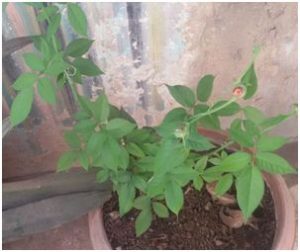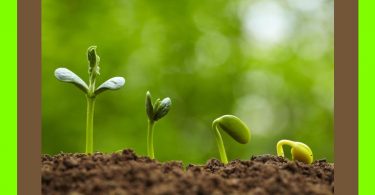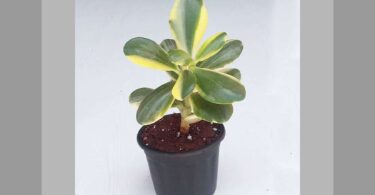Our plant doctors Radko Tichavshy, Mark Moodie and Pawan Singhania weigh in on your plant problems.
Radko TIchavsky Mark Moodie Pawan Singhania
Radko Tichavsky is a Czech born Mexican Agrohomeopath. He is the former director of Instituto Comenius at Mexico, author of Handbook of Agrohomeopathy, 2007 (Spanish) and Homepathy for Plants, 2009 (Spanish) and creator and teacher of Holohomeopathy. www.icomenius.edu.mx El 04/12/2014, a las 15:36, Radko Tichavsky [email protected]
Mark Moodie hosts the website Considera which provides a growing M.M and Repertory for plants and discusses resources for biodynamics and Agrohomeopathy The website allows the world community to contribute their experiences in planting
Dear Plant Doctors,
I fertilized all my garden plants with organic blood and bone a couple of months and all except for the palms started giving a good result. The palms have now gone brown and are drying out slowly. They also have some brown spots which I tried treating with vinegar & soap water spray but it hasn’t worked. Can you please suggest a remedy for the palms?
Melbourne has a highly fluctuating climate. Summer is November to Feb it’s between 12 to 38C and rains sometimes. Winter–2c to 17c with heavy rains and sunny afternoons, but the winter is very dry. Autumn & spring mostly feels like winter. The soil is very sticky and they say very good for roses.
Also, I have got Silicea 6CH and would like to use it for all the plants to give them a boost. Can I also use this for the dwarf Date Palms & Indoor bunglow palms (these are the ones getting the blood & bone).
Many thanks.
Shetty
Radko Tichavsky :
Dear M. Shetty,
I personally suggest not using any blood and bone in plants (albeit it is a fairly ingrained habit). It can cause toxicities and imbalances and pathogenic changes in soil and plants (indeed in nature these compounds are added to soil in very small quantities only occasionally and very slowly). Instead you can use compost made from plant waste. The problem with your plants is that they are located primarily in soil contaminated by high levels of nitrogen and decomposed blood.
Apply to the soil: Crot. horridus 6 CH and Carbo veg 12 CH alternated once a week for 1 month. The homeopathic remedies are specific for each type of plant. For example Silica 6 CH will have stimulating effect on some plants and not stimulating in others. There is not any universal remedy for stimulating all soils and all plants. Especially when applied repeatedly, Silicea may even have disastrous effects on crops. The individualization makes the difference between the work of an agro or holohomeopath and allopaths (either if the latter uses pesticides, synthetic fertilizers, herbal or even homeopathic remedies). It is always necessary to repertorize specific remedies for each plant species, biotype and vital status of the crop and the surrounding holon. There are no magic bullets. The only Hahnemannian method is conscious work on individualizated repertorisation, experimentation, and objective observation.
Mark Moody:
Dear M Shetty,
This is a surprising result as blood and bone tends not to have a really fast effect and really surprising that it is a negative impact. Are you sure that the palms were responding to the blood and bone?
It sure sounds like the palms are suffering. I’d search for the brown spots at and then read the entries in the linked material medica entries to see if any are pertinent to your situation. Silicea is gaining the reputation as a kind of panacea but that is a big title to live up to. However, we are all researchers so I suggest you try it on a couple and report back.
Greetings Plant Doctors,
Hello from the island of Crete in Greece. I just started using agrohomeopathy in my organic gardens and I need help to find remedies for weed control. The biggest problems in this 500sq. meters garden are Chrysanthemum coronarium, Urtica urens, Cynodon dactylon. I intend to plant onions and potatoes. The temperature at this time of year is between 4-18 celcius and the rainfall up today at about 600mm. I also need remedies for temperature sock and cold cloudy weather, for 30day tomatoes and eggplants in a 300 sqm greenhouse, since from last night began a strong northern wind and we expect even snow fall for about two days.
Thank you for your assistance.
Yiannis Kapetanakis – Crete.
Radko Tichavsky:
Dear Yiannis,
For weed control you can develop mulching, crop all plants without stirring the soil and sow Clovers (Trifolium spp.), once germinated the Clovers have to repeat the process over a cycle. It is important not to move the soil or only minimally because tillage breaks the roots and multiplies the weed. Chrysanthemum coronarium in your holon indicates a dry, low tillage soil. Urtica urens indicates deficiency of potassium, of phosphorus and good presence of nitrogen, also indicates a relatively good soil structure. I suggest you harvest Urtica and produce a fermented broth of it (half water and half of Urtica and let it ferment for two weeks, then apply diluted 1:20 in the field). This will balance soil deficiencies of potassium and phosphorus. You can also save this potion for insect control in the future. Like the Chrysanthemum, Coronarium contains pyrethrin, a very useful substance in the control of insects. You can prepare an alcoholic extract and save it for future use.
The first crop, instead of potato or onion, could be celery, carrot and / or lettuce for example, which are more conducive to this type of soil. As a first homeopathic application I suggest the nosode of soil 6 CH and Sulfur 6 CH, then Taraxacum officinalis 6 CH. With this you should have no any problems in crops. (continued on pages 2 + 3)
To the tomato and eggplants you can apply Larrea tridentata 12 CH sprayed once every three days. My tomatoes and eggplants survived temperatures near zero degrees Celsius with these applications.
Mark Moodie:
Hi Yiannis,
Weeds are a real issue for all those who are not into chemical blitzing. I don’t think we have the remedy in the agrohomeopathic chest but would be delighted to be proved wrong. I think that this is an issue of management and often, of sweat! There is an approach in the biodynamic school called peppering which has often been used in potency – see the forum at Considera for people’s experiences of these. I think it is also an immature technology – ie the parameters are not fully sorted yet.
For temperature shock – do you mean too cold? Try BdMax’s Thermomax, or Valerian or other remedies you can search under ‘frosts’. Too hot – there’s a few people tried sunburn remedies and it would be great if you tried one of these and reported back.
I have a ponytail palm that has white spots on the leaves I would like to find out if it will harm my palm and what to do to get rid of it.
Thank you
Beverly
Radko Tichavsky:
Dear Beverly,
the white dots on the Beaucarnea recurvata may be result of scraping of snails. They have not enough force to eat the leaf but they scrape the blade to stimulate output of sap which they feed on and thus promote infection by fungal diseases.
Apply sprayed: Chenopodium 6 CH and Plantago major 6 CH. Beaucarnea sp. requires brightly lit or sunny areas. Drought is better than it being too moist. Do not water before the previous watering has dried completely (you must check it with your finger) These two measures will control the disease.
Mark Moodie:
Hi Beverley
Whether it will harm them requires a good diagnostician. Some white spots are relatively benign and others need sorting quickly. As with your palmy sibling above, use the search function on the material medica and give one a go.
Dear Sirs,
How can I make the medium acidic for flowering plants like Azalea. We get liquid dilution which contains alcohol. As read that ferrous sulfate is used to make the medium acidic but it actually take months for this to work. I read in your blog about Sulphur 5ch. is it ok for flowering?
Also, I have an Emerald Jade vine plant which is most rare and endangered. It’s not growing and can’t show new shoots .
Regards
Robert
Radko Tichavsky:
Dear Robert,
if you have permeable soil with good drainage, it could be helpful to add 50% of peat moss (sphagnum) and 50% compost. If you have a clay soil, then adding the compost and sphagnum will not provide successful results. I suggest using cottonseed meal as fertilizer, mixed with pine needles. Applications of ferrous sulfate in the clay soil not only take months, but also contaminates the soil.
Sulphur 12 CH is ok in both types of soil. In the clay soil apply: Ammonium sulphuricum 6 CH and Apis mellifica 6 CH. This will balance the soil and revitalize plants.
To Strongylodon macrobotrys (jade vine) I suggest to applying Trifolium subterraneum 12 CH sprayed every two or three weeks and a one single application of Phosphorus 200 CH. As a suggestion, the Jade vine plant is very sensitive to the transplants; once put in place, it should not be moved anymore. In principle its growth is slow. It takes patience and after two or more years is accelerated and then flowers abundantly.
Mark Moodie:
Hi Robert
I am unaware of remedies altering the pH – you will need a horticulturalist to discuss the options. And sorry, but I’d also need to understand your question about flowering and sulphur clearer. So far in the materia medica https://considera.org/materiamedicagricultura.html?remtype=1&rem=594 we have the following experiences in relation to sulphur and flowering:
Premature flowering (3) [Kaviraj]
Rose leaves showed a coating of white mildew. It was sprayed 2x, once each week, with Sulphur 30 C. The fungus stopped spreading and the new leaves were healthy. (496) [via Narayana]
So, I’d say that neither of these – so far- indicate that the use of homeopathic Sulphur might be problematic for flowering. Test and report back please.
Hi Plant Doctors
I have on my balcony some potted plants, pomegranates and roses. In what month is it best to prune these plants. They have grown. 3 to 3 1/2 ft tall.
Thank you
Aspy from Pune
Radko Tichavsky :
Dear Aspy,
Prune your pomegranates in the fall (if it is not freezing) and during the waning moon. A few days before pruning apply once Hypericum perfoliatum 6 CH, and after pruning twice Arnica montana 6 CH. Pruned branches can be sealed with sealant to prevent fungal infections. Apply pruning in roses in autumn or winter, and depending on the vital force of each variety even between flowering sessions during the summer. Before pruning, spray with Hypericum perfoliatum 6 CH and after pruning, Zingiber officinalis 12 CH or Ocimum basilicum 12 CH. Also you should do pruning during the waning moon.
Dear Mr Radko Tichavsky,
Sir,
I am highly impressed and fascinated with your successful endeavor in the field of homeopathy application to the Agro sector and I hope your guidance will pave the way for me to enlighten my venture in the Horticulture farming sector. I have established a horticulture Nursery unit producing quality planting materials of various items like Mango, Cashew, Lemon, Guava, Litchi etc along with a farming orchard of vegetable production in the state of Odisha in INDIA. I request your guidance in selecting homeopathic remedies procedure of its application (potency) for sustainable growth and to keep them free from diseases. I am also a homeopathy practitioner.
With regards
S.N. Samanta INDIA [email protected]
Radko Tichavsky:
Dear S.N. Samantha,
Thanks for your beautiful resonance. The variety of crops and the short space of this column does not allow me to issue an accurate recommendation. Just an introduction: homeopathic repertorization of a crop is carried out under the specific conditions of each holon, ie the degree of vitality and soil characteristics, biotypes and variety of native plants, and interaction with cultural practices on crops. We take voltammetry data, refractometry and chromatography of plants, then we determine form of holons from air or satellite images and their degree of fragmentation. We observe prevailing biotypes and degrees of vitality of the holon. At this point we implement soil nosodes in specific potencies, some constitutional remedies (depending of specimen of plants and holon type) and miasmatic remedies. We frequently use available native plants from the holon as a basis for homeopathic remedies, This allows us to not rely on input from outside and reinforces the vital integrity in the holon. If you want to learn how to do it, Comenius Institute is offering an online course of a semester-long (we’re about to release a version in English) You can enroll at www.icomenius.edu.mx
As a gift I send you an image with the formation of holons in a region of southern India. It can be clearly seen as interconnected, as certain plots do not form any holons, and other plots form beautiful and strong holons (signs of great vitality and fertility).
Mark Moodie:
Hi S N Samanta
You address Radko so I am butting in. There are several homeopathic practitioners for agriculture in India who will, let us hope, be more familiar with local crops and conditions than I. Perhaps you can discuss this with Dr Murthy ( ), Abdul Lethif (no link) or SOS (http://www.swissorganicspray.com) and let us know how you get on please.
A Healthy Plant
This is the very same rose plant which was treated with homoeopthic medicines as per suggestions of Dr. Ahsan Waris. The plant is looking fresh and healthy. Please see the before and after treatment pictures below.
Thank you again Plant Doctors and Dr . Ahsan Waris!
Dr. Ravindra Madhukar Awasarkar
Before treatment After treatment
Mark Moodie: Excellent news – thanks!
Editor’s Note: Send your questions, with as much detail as possible (temperature of climate, rainfall, nearby plants etc. ) to:











Dear M. Shetty,
for your brown palms I suggest: Merc. M, 3 globules/10 l water, pour the Palms with this water 5 times. If you start at day x, you shall pour the plants at date x, x+5 days, x+18 days and then a month later from the latest date, and then again a month later. For example, you begin at the 20. march, then 25. march again, 12. April, 12. may and 12. June. Plus Lac lupus C500, 3 globules/10 l water, once at date x+30 days (in my example it is the 20. April). I would be happy, if you try this with some trees and report back. If you don’t get the remedies in exact potences, tell me please, we will find a solution. And stop fertilizing. I think, the Silicea wouldn’t work.
My Website is at the moment only in German (I have a nine-to-five job in mechanical Engineering): http://www.pflanzenretter.com
Regards, the plant savior from Germany, Sabine
Hallo dear Plant Doctors,
I am from Ukraine.
In my Garden is excess of shadow during the day, because in the morning the sun is hiding behind the house. It is big problem.
In the Garden are growing Hosta and Iris (Iridaceae) now.
Please, help me! My questios:
– How will make growing and flowering of my plants better?
– What homeopathic preparations are helping to growing of plants in shadow?
– Can you recommend more types of plants, who will to flower in excess of shadow?
Thanks you!
Hallo, Evgeniya,
I suggest SOL LM12, 3 globules in 10 litres of water, pour your plants with this water three times: date one, then one week later the second time, and after this date two weeks later for the last time.
Aurum M, 3 globules in 10 litres of water, pour once at the second date parallel with the SOL.
If you have problems to get the remedies in the exact potency (SOL is homeopathic sun, Aurum is gold, materilized sunlight), we can try this: You prepare ten litres of water in a bucket, tank…, you tell me via e-mail, when the water in the bucket is ready. Then I send mentally the info for the remedy into the water. It works, I can do remote healing, I tested your case with the help of radionics. I will send you also an e-mail, when I have sent the info into the water so that you can use it. Shall we try it? I work sometimes in this way with my daugther, who lives 200 km far away. It really works, my doc sent me very often “some energy”.
Regards from Germany, Sabine